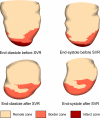Impact of surgical ventricular restoration on ventricular shape, wall stress, and function in heart failure patients
- PMID: 21357513
- PMCID: PMC3094088
- DOI: 10.1152/ajpheart.00021.2011
Impact of surgical ventricular restoration on ventricular shape, wall stress, and function in heart failure patients
Abstract
Surgical ventricular restoration (SVR) was designed to treat patients with aneurysms or large akinetic walls and dilated ventricles. Yet, crucial aspects essential to the efficacy of this procedure like optimal shape and size of the left ventricle (LV) are still debatable. The objective of this study is to quantify the efficacy of SVR based on LV regional shape in terms of curvedness, wall stress, and ventricular systolic function. A total of 40 patients underwent magnetic resonance imaging (MRI) before and after SVR. Both short-axis and long-axis MRI were used to reconstruct end-diastolic and end-systolic three-dimensional LV geometry. The regional shape in terms of surface curvedness, wall thickness, and wall stress indexes were determined for the entire LV. The infarct, border, and remote zones were defined in terms of end-diastolic wall thickness. The LV global systolic function in terms of global ejection fraction, the ratio between stroke work (SW) and end-diastolic volume (SW/EDV), the maximal rate of change of pressure-normalized stress (dσ*/dt(max)), and the regional function in terms of surface area change were examined. The LV end-diastolic and end-systolic volumes were significantly reduced, and global systolic function was improved in ejection fraction, SW/EDV, and dσ*/dt(max). In addition, the end-diastolic and end-systolic stresses in all zones were reduced. Although there was a slight increase in regional curvedness and surface area change in each zone, the change was not significant. Also, while SVR reduced LV wall stress with increased global LV systolic function, regional LV shape and function did not significantly improve.
Figures




Similar articles
-
Left ventricular regional wall curvedness and wall stress in patients with ischemic dilated cardiomyopathy.Am J Physiol Heart Circ Physiol. 2009 Mar;296(3):H573-84. doi: 10.1152/ajpheart.00525.2008. Epub 2009 Jan 2. Am J Physiol Heart Circ Physiol. 2009. PMID: 19122166 Free PMC article.
-
Effects of surgical ventricular restoration on left ventricular contractility assessed by a novel contractility index in patients with ischemic cardiomyopathy.Am J Cardiol. 2009 Mar 1;103(5):674-9. doi: 10.1016/j.amjcard.2008.10.031. Epub 2008 Dec 26. Am J Cardiol. 2009. PMID: 19231332
-
Restrictive mitral annuloplasty with or without surgical ventricular restoration in ischemic dilated cardiomyopathy with severe mitral regurgitation.Circulation. 2011 Sep 13;124(11 Suppl):S107-14. doi: 10.1161/CIRCULATIONAHA.110.010330. Circulation. 2011. PMID: 21911799
-
Clinical aspects of left ventricular diastolic function assessed by Doppler echocardiography following acute myocardial infarction.Dan Med Bull. 2001 Nov;48(4):199-210. Dan Med Bull. 2001. PMID: 11767125 Review.
-
Surgical left ventricular reconstruction.Gen Thorac Cardiovasc Surg. 2011 May;59(5):315-25. doi: 10.1007/s11748-010-0742-4. Epub 2011 May 6. Gen Thorac Cardiovasc Surg. 2011. PMID: 21547624 Review.
Cited by
-
Remodeling of left circumflex coronary arterial tree in pacing-induced heart failure.J Appl Physiol (1985). 2015 Aug 15;119(4):404-11. doi: 10.1152/japplphysiol.00262.2015. Epub 2015 Jul 9. J Appl Physiol (1985). 2015. PMID: 26159756 Free PMC article.
-
Reference Ranges for Left Ventricular Curvedness and Curvedness-Based Functional Indices Using Cardiovascular Magnetic Resonance in Healthy Asian Subjects.Sci Rep. 2020 May 21;10(1):8465. doi: 10.1038/s41598-020-65153-3. Sci Rep. 2020. PMID: 32439884 Free PMC article.
-
Image-based left ventricular shape analysis for sudden cardiac death risk stratification.Heart Rhythm. 2014 Oct;11(10):1693-700. doi: 10.1016/j.hrthm.2014.05.018. Epub 2014 May 20. Heart Rhythm. 2014. PMID: 24854217 Free PMC article.
-
Analysis of three-dimensional endocardial and epicardial strains from cardiac magnetic resonance in healthy subjects and patients with hypertrophic cardiomyopathy.Med Biol Eng Comput. 2018 Jan;56(1):159-172. doi: 10.1007/s11517-017-1674-2. Epub 2017 Jul 3. Med Biol Eng Comput. 2018. PMID: 28674779
-
Numerical Modeling of Intraventricular Flow during Diastole after Implantation of BMHV.PLoS One. 2015 May 11;10(5):e0126315. doi: 10.1371/journal.pone.0126315. eCollection 2015. PLoS One. 2015. PMID: 25961285 Free PMC article.
References
-
- Aikawa Y, Rohde L, Plehn J, Greaves SC, Menapace F, Arnold MO, Rouleau JL, Pfeffer MA, Lee RT, Solomon SD. Regional wall stress predicts LV remodeling after anteroseptal myocardial infarction in the healing and early afterload reducing trial (HEART): an echocardiography-based structural analysis. Am Heart J 141: 234–242, 2001 - PubMed
-
- Athanasuleas CL, Stanley AW, Jr, Buckberg GD, Dor V, Di Donato M, Blackstone EH. Surgical anterior ventricular endocardial restoration (SAVER) in the dilated remodeled ventricle after anterior myocardial infarction. RESTORE group Reconstructive Endoventricular Surgery, returning Torsion Original Radius Elliptical Shape to the LV. J Am Coll Cardiol 37: 1199–1209, 2001 - PubMed
-
- Bogaert J, Bosmans H, Maes A, Suetens P, Marchal G, Rademakers FE. Remote myocardial dysfunction after acute anterior myocardial infarction: impact of left ventricular shape in regional function. J Am Coll Cardiol 35: 1525–1534, 2000 - PubMed
-
- Braunwald E. Heart Disease: A Textbook of Cardiovascular Disease. (5th ed.) Philadelphia: Saunders, 1997
-
- Buckberg GD, Athanasuleas CL, Wechsler AS, Beyersdorf F, Conte JV, Strobeck JE. The STICH Trial unraveled. Eur J Heart Fail 12: 1024–1027, 2010 - PubMed
Publication types
MeSH terms
Grants and funding
LinkOut - more resources
Full Text Sources
Medical

